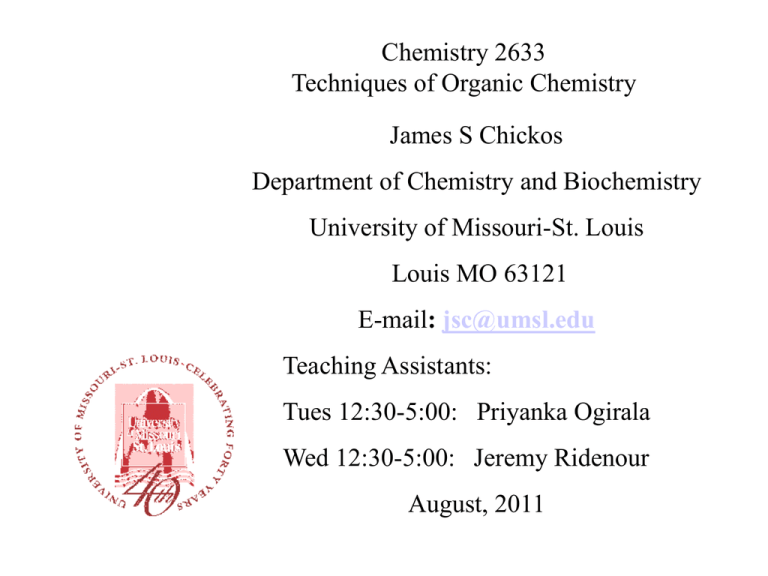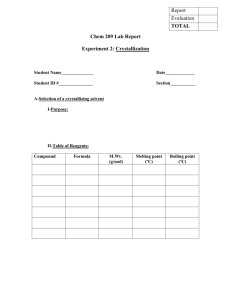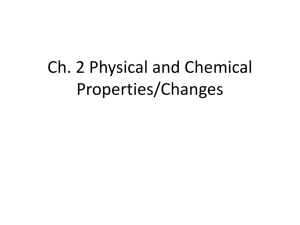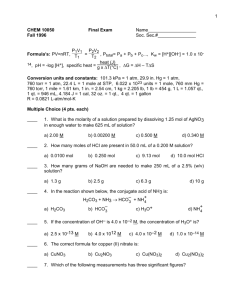Next week - University of Missouri
advertisement

Chemistry 2633 Techniques of Organic Chemistry James S Chickos Department of Chemistry and Biochemistry University of Missouri-St. Louis Louis MO 63121 E-mail: jsc@umsl.edu Teaching Assistants: Tues 12:30-5:00: Priyanka Ogirala Wed 12:30-5:00: Jeremy Ridenour August, 2011 Next week (CH3CO)2O CO2H CO2H + CH3CO2H OH H2SO4 OCCH3 O 1. Mix the appropriate reagents and heat on a water bath; 2. Cool in ice and scratch until solid forms; 3. Add cold water and break up solid; 4. Filter and wash with cold water; 5. Dissolve the wet aspirin in NaHCO3; O O OCCH3 NaHCO3 OCCH3 + CO2 CO2H CO2 -1 HCl pH 1 O OCCH3 + CO2 CO2H A likely structure of the tacky polymer O O O O O O O O O O O Next week (CH3CO)2O CO2H CO2H + CH3CO2H OH H2SO4 OCCH3 O 1. Mix the appropriate reagents and heat on a steam bath; 2. Cool in ice and scratch until solid forms; 3. Add cold water and break up solid; 4. Filter and wash with cold water; 5. Dissolve the wet aspirin in NaHCO3; 6. Filter to remove polymer (tacky insoluble material); (save liquid) 7. Acidify to pH ~ 1, filter (suction filtration) 8. Allow to dry until next week. Typical Calculations in Organic Chemistry Laboratory (CH3CO)2O CO2H CO2H + CH3CO2H OH OCCH3 salicylic acid: MW = 138 material used: 3.0 g acetic anhydride: MW =102 material used: 5.0 mL density: 1.10 g/mL aspirin isolated: 3.0 g What is the limiting reagent? What is the yield? O (CH3CO)2O CO2H 102 g/mol CO2H + CH3CO2H OH OCCH3 3 g used 138 g/mol 3g/138g/mol = 0.0217 mol SA 3 g isolatedO 180 g/mol 5 mL*1.10 g/mL = 5.5 g/102 = 0.0539 mol AA The limiting reagent is SA; Why is SA made the limiting reagent and not AA? The theoretical yield is? 0.0217 mol *180 g/mol = 3.906 g Aspirin % Yield: 3.0/3.906 = 0.768*100 = 76.8 % Why is the yield less than 100%? 1. Loss due to transfers 2. assume 100 % reaction 3. assume limiting reagent is 100 % pure 4. solubility of aspirin in water How do we know that what we isolated is aspirin? 1. One way is by comparing the physical properties of the material we isolated to that of pure aspirin What physical properties? Melting properties of a pure material melting temperature T / °C first crystal forms, supercooling Added heat remove heat Melting properties of an impure material solid disappears T / °C beginning and ending of melting liquid appears Added heat 1. Melting point of a known material should melt within 1-2 °C of the value reported previously. 2. Melting point of a pure material melts sharply; If a compound melts sharply, is it necessarily a pure material? mp (pure A) mp (pure B) A B °C °C 100 % A Temperature 100 % B The melting point behavior of a simple binary mixture liquid + solid liquid region A B Temperature °C solid region 100 % A 100 % B time The melting point behavior of a simple binary mixture A B °C °C 100 % A 100 % B The melting point behavior of a simple binary mixture A B °C eutectic 100 % A 100 % B time The melting point behavior of a simple binary mixture at the eutectic composition The eutectic point is the lowest temperature solid and liquid exists in equilibrium A B °C °C 100 % A AB 100 % B The melting point behavior of a more complex mixture A B °C °C dl 100 % d-menthol 100 % l-menthol The melting point of a chiral system Many chiral systems exhibit this type of behavior (for example: dl menthol) How do we purify an impure material? A. solid B. liquid C. gas 1. Solids: recrystallization impure liquid material Slow crystallization Fast crystallization Why doesn’t the blue material crystallize? What are the factors affecting the quality of the crystal obtained? 1. rate of crystal growth 2. nature of the solvent and of the impurity Factors affecting the amount of the crystal obtained: 1. solubility of materials in the solvent 2. temperature How to choose a solvent for recrystallization? 1. Choose a solvent similar in polarity to the compounds being recrystallized -like dissolves like- polar solvents dissolve polar substrates; non-polar substrates dissolve non polar substrates 2. Choose a solvent with a reasonable boiling point Why? When will crystallization work? 1. If the material is reasonably pure to begin with 90+%. 2. The impurities have different properties including polarity, solubility, structure Solubility g/mL 25 °C Temperature If solid A has a solubility of 1 g /100mL of solvent at 25 °C and 15 g at its boiling temperature, how much can you recover by recrystallization of 167 g of this material if it is 90% pure? Lets assume the impurity has a similar solubility. If we use a minimum amount of boiling solvent to dissolve this material, how much solvent must we use? 167g *0.9 = 150.3 g of A requires 1000 mL of boiling solvent At 25 °C, 10 g of A will remain in solution along with the impurity. Thus 140 g will be recovered. In order to achieve good separation, the solid and liquid should be separated as quantitatively as possible. Any solvent that evaporates on the solid will deposit dissolved materials. Typical Solvents in Organic Laboratory (in decreasing polarity) Green Solvents water, methanol, ethanol, 1, and 2-propanol, 1-butanol, t-butanol acetone, 2-butanone, ethyl acetate Usable solvents acetic acid, dimethyl sulfoxide, acetonitrile, tetrahydrofuran, toluene, xylenes, cyclohexane, heptane, isooctane Undesirable dimethylformamide, pyridine, dioxane, diethyl ether, diisopropyl ether, chloroform, dichloromethane, carbon tetrachloride benzene, pentane, hexane





